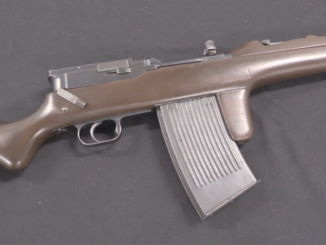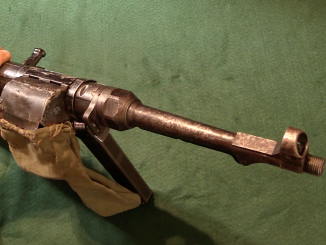One of the scarce, small-production manufacturers of the Luger is Krieghoff – Heinrich Krieghoff to be exact. Kreighoff Waffenfabrik was a smallish arms company that wanted to get into major contracts with the rearming German military in the 1930s. They began by bidding on a contract for 10,000 Luger pistols for the Luftwaffe, and won. Krieghoff had previously worked as a subcontractor for the Simson company rebuilding Lugers under the Weimar government. Kreighoff got control of the Simson Luger tooling, and used it to manufacture a new set themselves.
Krieghoff built a total of 13,825 Luger pistols. The first 10,000 were delivered to the Luftwaffe between 1935 and 1937. A further 2,000 were delivered in small batches between 1940 and 1944, with a final 200 in 1945. In addition to these, 1,625 were sold commercially, including a few highly embellished examples. They are renowned for their excellent quality, and have always attracted particular collector interest.




Notable ground elements of the Luftwaffe
The FLAK – Flugzeug Abwehr Kannon (“Antiaircraft Gun”) – the Air Defense Artillery
The Fallschirmjager – Paratroops (five divisions)
https://en.wikipedia.org/wiki/Fallschirmjäger
The Fallschirm Panzer Korps Herman Goering – Eventually a panzer and panzer grenadier division with Corps heaquarters and Corps troops
https://en.wikipedia.org/wiki/1st_Fallschirm-Panzer_Division_Hermann_G%C3%B6ring
Luftwaffe Field Divisions – Scraped up from ground crews with no planes to maintain, etc, handed rifles and sent to the front where they promptly disintegrated
https://en.wikipedia.org/wiki/Luftwaffe_Field_Divisions
Any of these might have had pistols issued to them
A little correction: FLAK is actually short for FlugAbwehrKanone. Literal translation would be something like “Air Defense Cannon” (or Gun in modern English parlance), correct translation is indeed Anti-Aircraft Gun.
I would suspect the Lugers were reserved for the Fallschirmjäger and Panzer Korps. Others probably got some “substitute standard” 7.65mm (.32 ACP) pistols, if they were lucky. Shortage of pistols was so bad that even 6.35mm (.25 ACP) pocket pistols were issued at least to pilots, as LDC already wrote below.
7,65 mm Browning cartridge was considered standard for Luftwaffe personnel, they even ordered 7,65 mm Browning version of 9×17 Kurz weapon namely Pistole 37 (u)
http://hungariae.com/FromP37.htm
which is version of Frommer Fémáru Pisztoly 37.M
http://hungariae.com/From37.htm
in one of Axis countries.
@Col beausabre
The relatively early production date probably indicates that they were were mostly used by Luftwaffe officers, pilots and Fallschirmjagers.
These guns weren’t likely to be warehoused for years before being passed out to LW Fielddivisions, FLAK batteries and the like later in the war. LW was growing FAST 36-39.
Later LW units: 1940 and onwards were more likely to be equipped with whatever they could get their hands on, like the Waffen SS who in some cases got MP28s.
Fortunately for LW, they had plenty of small arms from Poland, Scandinavia, France and Belgium available after 1940
Hans-Ulrich Rudel, in his memoirs, mentions the handguns he and his crew were armed with when shot down and escaping from behind Russian lines. I think the numbers 7.65 and 6.35 (!) were mentioned. The translator used the word “revolver”!
One history of the Battle of Britain (either Derek Robinson’s or Len Deighton’s) notes that the German fighter pilots did not have any kind of life vest or life raft on board; after the bodies of several pilots washed ashore in France with single bullet wounds to the head the pilots were forbidden from carrying any kind of pistol. In addition the pilots got no leave or time off; squadron surgeons were reduced to diagnosing appendicitis and performing unnecessary surgeries to give the pilots any rest. There were suicides, and morale further dropped at the prospect of being burnt to death in midair or drowned with no relatively painless available escape.
Hah. Now that’s some classic British war propaganda.
@Walter Logins
Next he’ll tell us about all the Belgian nuns that were raped and crucified in 1914 😉
Please see reply to Victor below.
Sounds like BS and British propaganda from the 40ies.
You do realize the Germans had entire Eboot squadrons whose main purpose was to rescue downed pilots, yes?
And pilots getting no leave or time off? ITS A WAR! One of the real wars, not the kind where you have a Burger King on your FOB.
Both sides were knackered, both sides overworked their pilots into exhaustion.
It’s like the myth that IJN pilots never wore parachutes because they wanted to die heroically for the Emperor.
In his postwar book, Saburo Sakai explained that yes, they always wore parachutes, but rarely used them in an emergency due to a failure rate they considered unacceptable. The A6M fighter (“Zero” or “Zeke”) was actually fairly easy to ditch or crashland in an emergency, floated for a reasonable amount of time, and was easy to exit after a belly-landing or etc. All factors deliberately designed into it by Jiro Horikoshi and his team at Mitsubishi.
As such, pilots preferred to ride the plane down because it actually increased their chances of not only surviving, but not even getting hurt too much.
cheers
eon
Answer as well to Mr. Logins: Sorry for tardy reply but I don’t own the book anymore, which necessitated a trip to the library. “Invasion 1940” by Derek Robinson, Carroll & Graf, 2015, pp. 167-168. A review of photographs of Luftwaffe pilots show them wearing life vests, so I withdraw that assertion. I’m sure the big roomy bombers carried rafts. I am aware of the German air-sea rescue services, both E-Boats and floatplanes, however the British were shooting at all of those, and in any case any pilot not found by nightfall was a certain goner from hypothermia.
As to pilot rotation, I quote: [RAF Commander] “Dowding revolved his squadrons, moving tired ones out of the combat zone so they could rebuild their strength. Goering did not. A German pilot stayed on operations until he died or was wounded or got promoted out of the fight.” The disarming order was given in September 1940, which might have also eased the pistol shortage somewhat. The author cites what sure looks like a German source, “Spitfire on My Tail,” by Ulrich Steinhilper, who was at one point Adolf Galland’s adjutant.
I must say I am impressed that you gentlemen reached out after all these decades to defend the honor of the brave Luftwaffe pilots who tirelessly fought to bring tyranny, forced labor and mass murder across the English Channel. I make no assertion about Belgian nuns in 1914.
@LDC
Aaand you continue to push wartime propaganda with your “bring tyranny m, forced labor and mass murder across the English Channel”, which is of course nonsensical.
Germany had little interest in invading Britain, but were seeking a political solution, or failing that: Bombing the country into a ceasefire.
When I was referring to BOTH sides being exhausted and riding their pilots hard, I was of course referring to the early desperate months of the Battle of Britain, where the UK only had a few hundred battleworthy planes at any point in time. By September the situation was drastically different, the BOB was practically over and Dowding could “afford” to rotate tired units away.
Okay, have it your way. You are maintaining the honor of the brave tireless Luftwaffe pilots who crossed the Channel daily to maintain tyranny, forced labor, and mass murder in Continental Europe.
The early type1 FG42s were also manufactured by Kriegoff. The Fallschirmjager troops certainly couldn’t complain about the quality of their issued weapons.
“(…)Kriegoff(…)”
Now I confused. You seems to praise quality of products company, yet you do corrupt its’ name, so do you praise or disdain?
It’s a “typo”, short for “typographical error”. It does not signify either respect or disdain for the company in question.
Typo I assure you as I only know the hunt and peck method. I have a pair of K-80s so the proper spelling is familiar.
Krieghoff still exists. They build exquisite hunting rifles, competition shotguns and the “Semprio” that would be worth to be covered on forgotten weapons.com
“(…)Krieghoff – Heinrich Krieghoff(…)Kreighoff Waffenfabrik(…)Kreighoff(…)Krieghoff(…)”
So far I know it is Krieghoff (i before e) i.e. like in Kriegsspiel (wargame). Heinrich Krieghoff, Suhl did earlier made automatic pistols, namely was one of makers (subcontractor) of Walther Modell 4 automatic pistol
http://historypistols.ru/blog/pistolety-pod-unitarnyj-patron-avtomaticheskie/pistolet-valter-model-4-walther-model-4/
Pilots dislike large pistols, and Luftwaffe pilots are no exception.
They preferred something light and compact like the FN M1910, FN M1922, Mauser HSc, Walther PP, Ets.
For a pilot, a pistol is not a weapon. This is in case of meeting with Hyena or falling into a completely desperate situation.
I think these Lugers were intended for security and air defense units.
However, the power of the cartridge has to be considered. if you’re anticipating facing an attacking predator, shooting near it with a small caliber weapon to scare it off might work, but if it doesn’t, you’d probably want something with enough killing power to deal with it before it gets to you. Which in the German inventory pretty much means the 9 x 19mm in a pistol.
It’s not a coincidence that the Luftwaffe M30 drilling rifle/shotgun is a 12-gauge side-by-side double over a 9.3 x 74mmR rifle barrel. The latter being intended for medium-to-large game animals like wild boar.
Handy to have when something local decides to find out how you taste.
cheers
eon
@eon
Predators were hardly a consideration for the vast majority of LW pilots, who for whatever reason had to crash land or parachute out.
The Drilling was only ever issued to LW pilots serving in Africa. For most pilots a small caliber was preferable.
For those interested in Luftwaffe movies involving the luger pistol, INTO THE WHITE dvd is available from amazon. I tells the story of a german bomber crew shot down in Norway by a British fighter plane. The use of the Luger pistol is seen in numerous scenes. A very good movie for this subject.
The Luftwaffe Field Divisions were appalling.
von Mellethin writes about them – I have a PDF, but not searchable, so I can’t paste, but he says they were Luftwaffe troops, taken from their Luffwaffe roles and with *no training* put into the equivalent Army roles; so for example the division intelligence officer was a former Luftwaffe intelligene officer, who was probably perfectly good at his role in the Luftwaffe but knew *nothing* about doing the same job n the Army.
When these units went into the line, in the East, ten thousand men plus per unit, and were finished – utterly destroyed – in a few days.
@Joe Twoshoot
You’re not wrong, and it was mostly a result of the never ending bureaucratic powerstruggles/organizational mess of the Third Reich.
OKW: “We’re losing men quickly on the Eastern Front! Quicker than we can replace them! Say… The Luftwaffe sure has a lot of ground crews and such! Maybe we could use them?”
Luftwaffe: “OK but they stay under OUR control!”
@LDC
I’m glad you at least were man enough to admit that your original claim was British war propaganda.
(As is your claim that Luftwaffe had any interest in bringing “forced labor and tyranny” across the channel.)
German occupation policy was always dependent on time and place. So while we saw forced labor and lapankas being used in Poland for example, as the war situation drew increasingly dire, in other countries there was no such thing. The Western countries mostly got the carrot and not the stick.
In fact, Denmark despite being normally occupied, had a higher standard of living than Germany during the war, and willingly contributed to the German war effort. Even going as far as sending troops.
Likewise, the reason Heydrich got assassinated in Bohemia, was because he was an effective administrator and mostly managed to get the Czech workers on board through pay increases and higher standards of living.
Churchill rightfully calculated that assassinating an efficient administrator like Heydrich would bring a brutal response, and in this he was correct: Czech lives be damned.